Supraclavicular Node Breast Cancer: Radiation Therapy Evaluation
VerifiedAdded on 2023/06/15
|6
|1448
|59
Report
AI Summary
This report provides an evaluation of radiation therapy treatments for breast cancer, with a specific focus on the management of supraclavicular nodes. It explores various techniques, including beam arrangements like tangential field techniques, the use of 6MV energy, and the mono-isocentric technique. The report also discusses the challenges faced during treatment and considerations for regional nodal irradiation (RNI). Furthermore, it outlines the ICRU guidelines for radiation therapy treatment, emphasizing the importance of accurate measurement and application of radiation to minimize side effects. References to relevant studies and research are included to support the analysis of different radiotherapy approaches for breast cancer.

Running head: RADIATION THERAPY TREATMENTS FOR BREAST CANCER
Radiation Therapy Treatments for Breast Cancer
Name of the Student
Name of the University
Author Note
Radiation Therapy Treatments for Breast Cancer
Name of the Student
Name of the University
Author Note
Paraphrase This Document
Need a fresh take? Get an instant paraphrase of this document with our AI Paraphraser
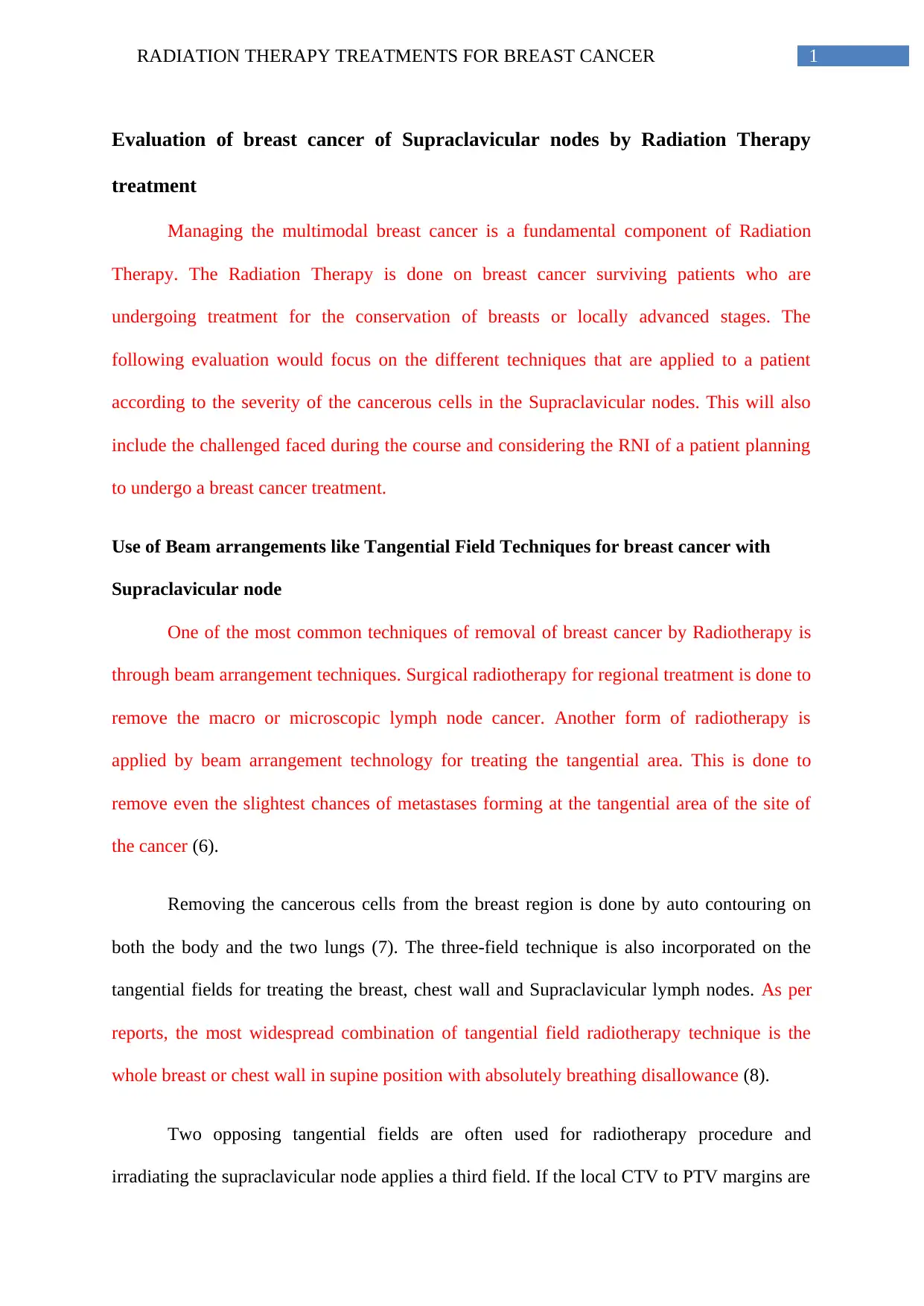
1RADIATION THERAPY TREATMENTS FOR BREAST CANCER
Evaluation of breast cancer of Supraclavicular nodes by Radiation Therapy
treatment
Managing the multimodal breast cancer is a fundamental component of Radiation
Therapy. The Radiation Therapy is done on breast cancer surviving patients who are
undergoing treatment for the conservation of breasts or locally advanced stages. The
following evaluation would focus on the different techniques that are applied to a patient
according to the severity of the cancerous cells in the Supraclavicular nodes. This will also
include the challenged faced during the course and considering the RNI of a patient planning
to undergo a breast cancer treatment.
Use of Beam arrangements like Tangential Field Techniques for breast cancer with
Supraclavicular node
One of the most common techniques of removal of breast cancer by Radiotherapy is
through beam arrangement techniques. Surgical radiotherapy for regional treatment is done to
remove the macro or microscopic lymph node cancer. Another form of radiotherapy is
applied by beam arrangement technology for treating the tangential area. This is done to
remove even the slightest chances of metastases forming at the tangential area of the site of
the cancer (6).
Removing the cancerous cells from the breast region is done by auto contouring on
both the body and the two lungs (7). The three-field technique is also incorporated on the
tangential fields for treating the breast, chest wall and Supraclavicular lymph nodes. As per
reports, the most widespread combination of tangential field radiotherapy technique is the
whole breast or chest wall in supine position with absolutely breathing disallowance (8).
Two opposing tangential fields are often used for radiotherapy procedure and
irradiating the supraclavicular node applies a third field. If the local CTV to PTV margins are
Evaluation of breast cancer of Supraclavicular nodes by Radiation Therapy
treatment
Managing the multimodal breast cancer is a fundamental component of Radiation
Therapy. The Radiation Therapy is done on breast cancer surviving patients who are
undergoing treatment for the conservation of breasts or locally advanced stages. The
following evaluation would focus on the different techniques that are applied to a patient
according to the severity of the cancerous cells in the Supraclavicular nodes. This will also
include the challenged faced during the course and considering the RNI of a patient planning
to undergo a breast cancer treatment.
Use of Beam arrangements like Tangential Field Techniques for breast cancer with
Supraclavicular node
One of the most common techniques of removal of breast cancer by Radiotherapy is
through beam arrangement techniques. Surgical radiotherapy for regional treatment is done to
remove the macro or microscopic lymph node cancer. Another form of radiotherapy is
applied by beam arrangement technology for treating the tangential area. This is done to
remove even the slightest chances of metastases forming at the tangential area of the site of
the cancer (6).
Removing the cancerous cells from the breast region is done by auto contouring on
both the body and the two lungs (7). The three-field technique is also incorporated on the
tangential fields for treating the breast, chest wall and Supraclavicular lymph nodes. As per
reports, the most widespread combination of tangential field radiotherapy technique is the
whole breast or chest wall in supine position with absolutely breathing disallowance (8).
Two opposing tangential fields are often used for radiotherapy procedure and
irradiating the supraclavicular node applies a third field. If the local CTV to PTV margins are
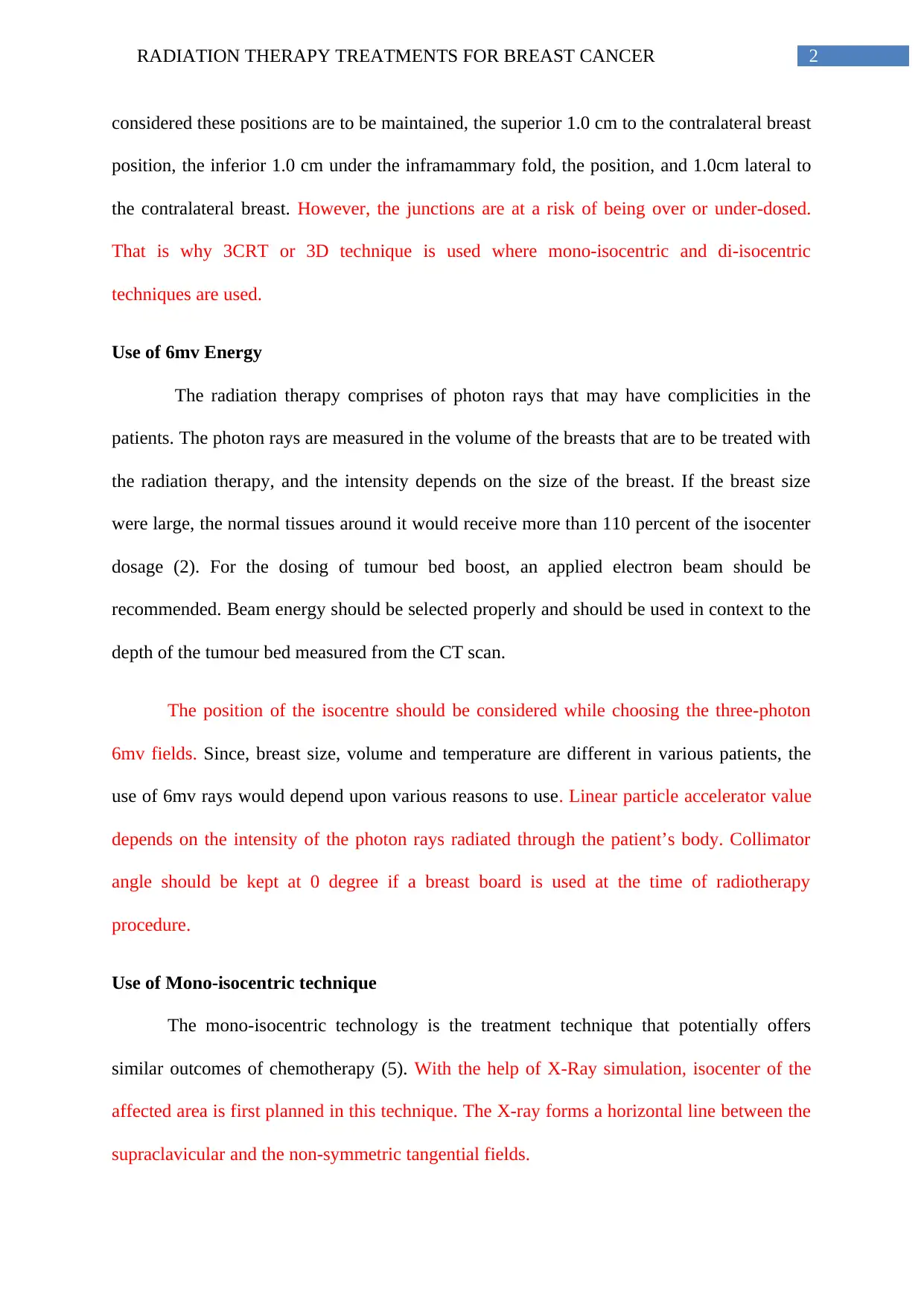
2RADIATION THERAPY TREATMENTS FOR BREAST CANCER
considered these positions are to be maintained, the superior 1.0 cm to the contralateral breast
position, the inferior 1.0 cm under the inframammary fold, the position, and 1.0cm lateral to
the contralateral breast. However, the junctions are at a risk of being over or under-dosed.
That is why 3CRT or 3D technique is used where mono-isocentric and di-isocentric
techniques are used.
Use of 6mv Energy
The radiation therapy comprises of photon rays that may have complicities in the
patients. The photon rays are measured in the volume of the breasts that are to be treated with
the radiation therapy, and the intensity depends on the size of the breast. If the breast size
were large, the normal tissues around it would receive more than 110 percent of the isocenter
dosage (2). For the dosing of tumour bed boost, an applied electron beam should be
recommended. Beam energy should be selected properly and should be used in context to the
depth of the tumour bed measured from the CT scan.
The position of the isocentre should be considered while choosing the three-photon
6mv fields. Since, breast size, volume and temperature are different in various patients, the
use of 6mv rays would depend upon various reasons to use. Linear particle accelerator value
depends on the intensity of the photon rays radiated through the patient’s body. Collimator
angle should be kept at 0 degree if a breast board is used at the time of radiotherapy
procedure.
Use of Mono-isocentric technique
The mono-isocentric technology is the treatment technique that potentially offers
similar outcomes of chemotherapy (5). With the help of X-Ray simulation, isocenter of the
affected area is first planned in this technique. The X-ray forms a horizontal line between the
supraclavicular and the non-symmetric tangential fields.
considered these positions are to be maintained, the superior 1.0 cm to the contralateral breast
position, the inferior 1.0 cm under the inframammary fold, the position, and 1.0cm lateral to
the contralateral breast. However, the junctions are at a risk of being over or under-dosed.
That is why 3CRT or 3D technique is used where mono-isocentric and di-isocentric
techniques are used.
Use of 6mv Energy
The radiation therapy comprises of photon rays that may have complicities in the
patients. The photon rays are measured in the volume of the breasts that are to be treated with
the radiation therapy, and the intensity depends on the size of the breast. If the breast size
were large, the normal tissues around it would receive more than 110 percent of the isocenter
dosage (2). For the dosing of tumour bed boost, an applied electron beam should be
recommended. Beam energy should be selected properly and should be used in context to the
depth of the tumour bed measured from the CT scan.
The position of the isocentre should be considered while choosing the three-photon
6mv fields. Since, breast size, volume and temperature are different in various patients, the
use of 6mv rays would depend upon various reasons to use. Linear particle accelerator value
depends on the intensity of the photon rays radiated through the patient’s body. Collimator
angle should be kept at 0 degree if a breast board is used at the time of radiotherapy
procedure.
Use of Mono-isocentric technique
The mono-isocentric technology is the treatment technique that potentially offers
similar outcomes of chemotherapy (5). With the help of X-Ray simulation, isocenter of the
affected area is first planned in this technique. The X-ray forms a horizontal line between the
supraclavicular and the non-symmetric tangential fields.
⊘ This is a preview!⊘
Do you want full access?
Subscribe today to unlock all pages.

Trusted by 1+ million students worldwide
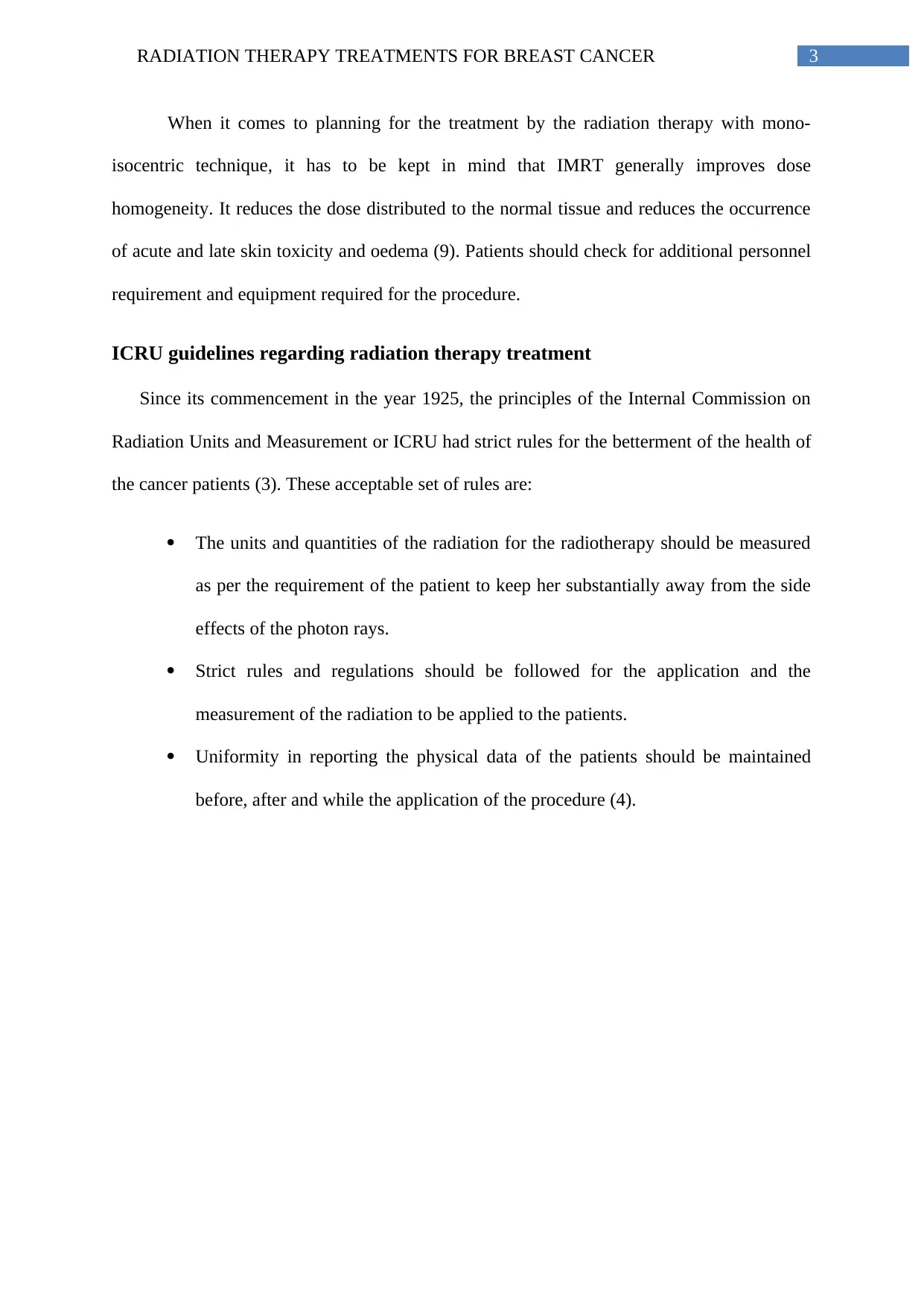
3RADIATION THERAPY TREATMENTS FOR BREAST CANCER
When it comes to planning for the treatment by the radiation therapy with mono-
isocentric technique, it has to be kept in mind that IMRT generally improves dose
homogeneity. It reduces the dose distributed to the normal tissue and reduces the occurrence
of acute and late skin toxicity and oedema (9). Patients should check for additional personnel
requirement and equipment required for the procedure.
ICRU guidelines regarding radiation therapy treatment
Since its commencement in the year 1925, the principles of the Internal Commission on
Radiation Units and Measurement or ICRU had strict rules for the betterment of the health of
the cancer patients (3). These acceptable set of rules are:
The units and quantities of the radiation for the radiotherapy should be measured
as per the requirement of the patient to keep her substantially away from the side
effects of the photon rays.
Strict rules and regulations should be followed for the application and the
measurement of the radiation to be applied to the patients.
Uniformity in reporting the physical data of the patients should be maintained
before, after and while the application of the procedure (4).
When it comes to planning for the treatment by the radiation therapy with mono-
isocentric technique, it has to be kept in mind that IMRT generally improves dose
homogeneity. It reduces the dose distributed to the normal tissue and reduces the occurrence
of acute and late skin toxicity and oedema (9). Patients should check for additional personnel
requirement and equipment required for the procedure.
ICRU guidelines regarding radiation therapy treatment
Since its commencement in the year 1925, the principles of the Internal Commission on
Radiation Units and Measurement or ICRU had strict rules for the betterment of the health of
the cancer patients (3). These acceptable set of rules are:
The units and quantities of the radiation for the radiotherapy should be measured
as per the requirement of the patient to keep her substantially away from the side
effects of the photon rays.
Strict rules and regulations should be followed for the application and the
measurement of the radiation to be applied to the patients.
Uniformity in reporting the physical data of the patients should be maintained
before, after and while the application of the procedure (4).
Paraphrase This Document
Need a fresh take? Get an instant paraphrase of this document with our AI Paraphraser
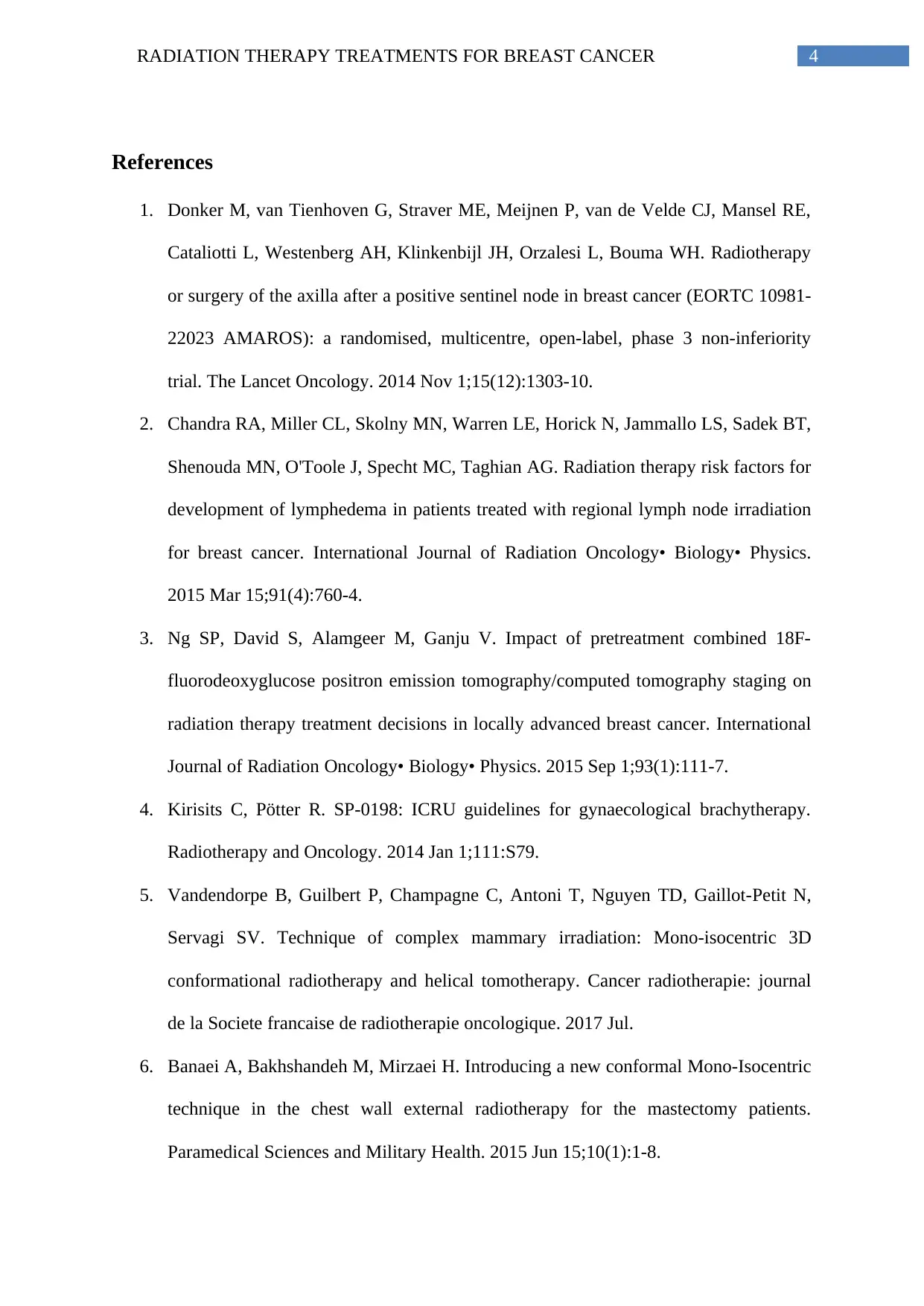
4RADIATION THERAPY TREATMENTS FOR BREAST CANCER
References
1. Donker M, van Tienhoven G, Straver ME, Meijnen P, van de Velde CJ, Mansel RE,
Cataliotti L, Westenberg AH, Klinkenbijl JH, Orzalesi L, Bouma WH. Radiotherapy
or surgery of the axilla after a positive sentinel node in breast cancer (EORTC 10981-
22023 AMAROS): a randomised, multicentre, open-label, phase 3 non-inferiority
trial. The Lancet Oncology. 2014 Nov 1;15(12):1303-10.
2. Chandra RA, Miller CL, Skolny MN, Warren LE, Horick N, Jammallo LS, Sadek BT,
Shenouda MN, O'Toole J, Specht MC, Taghian AG. Radiation therapy risk factors for
development of lymphedema in patients treated with regional lymph node irradiation
for breast cancer. International Journal of Radiation Oncology• Biology• Physics.
2015 Mar 15;91(4):760-4.
3. Ng SP, David S, Alamgeer M, Ganju V. Impact of pretreatment combined 18F-
fluorodeoxyglucose positron emission tomography/computed tomography staging on
radiation therapy treatment decisions in locally advanced breast cancer. International
Journal of Radiation Oncology• Biology• Physics. 2015 Sep 1;93(1):111-7.
4. Kirisits C, Pötter R. SP-0198: ICRU guidelines for gynaecological brachytherapy.
Radiotherapy and Oncology. 2014 Jan 1;111:S79.
5. Vandendorpe B, Guilbert P, Champagne C, Antoni T, Nguyen TD, Gaillot-Petit N,
Servagi SV. Technique of complex mammary irradiation: Mono-isocentric 3D
conformational radiotherapy and helical tomotherapy. Cancer radiotherapie: journal
de la Societe francaise de radiotherapie oncologique. 2017 Jul.
6. Banaei A, Bakhshandeh M, Mirzaei H. Introducing a new conformal Mono-Isocentric
technique in the chest wall external radiotherapy for the mastectomy patients.
Paramedical Sciences and Military Health. 2015 Jun 15;10(1):1-8.
References
1. Donker M, van Tienhoven G, Straver ME, Meijnen P, van de Velde CJ, Mansel RE,
Cataliotti L, Westenberg AH, Klinkenbijl JH, Orzalesi L, Bouma WH. Radiotherapy
or surgery of the axilla after a positive sentinel node in breast cancer (EORTC 10981-
22023 AMAROS): a randomised, multicentre, open-label, phase 3 non-inferiority
trial. The Lancet Oncology. 2014 Nov 1;15(12):1303-10.
2. Chandra RA, Miller CL, Skolny MN, Warren LE, Horick N, Jammallo LS, Sadek BT,
Shenouda MN, O'Toole J, Specht MC, Taghian AG. Radiation therapy risk factors for
development of lymphedema in patients treated with regional lymph node irradiation
for breast cancer. International Journal of Radiation Oncology• Biology• Physics.
2015 Mar 15;91(4):760-4.
3. Ng SP, David S, Alamgeer M, Ganju V. Impact of pretreatment combined 18F-
fluorodeoxyglucose positron emission tomography/computed tomography staging on
radiation therapy treatment decisions in locally advanced breast cancer. International
Journal of Radiation Oncology• Biology• Physics. 2015 Sep 1;93(1):111-7.
4. Kirisits C, Pötter R. SP-0198: ICRU guidelines for gynaecological brachytherapy.
Radiotherapy and Oncology. 2014 Jan 1;111:S79.
5. Vandendorpe B, Guilbert P, Champagne C, Antoni T, Nguyen TD, Gaillot-Petit N,
Servagi SV. Technique of complex mammary irradiation: Mono-isocentric 3D
conformational radiotherapy and helical tomotherapy. Cancer radiotherapie: journal
de la Societe francaise de radiotherapie oncologique. 2017 Jul.
6. Banaei A, Bakhshandeh M, Mirzaei H. Introducing a new conformal Mono-Isocentric
technique in the chest wall external radiotherapy for the mastectomy patients.
Paramedical Sciences and Military Health. 2015 Jun 15;10(1):1-8.
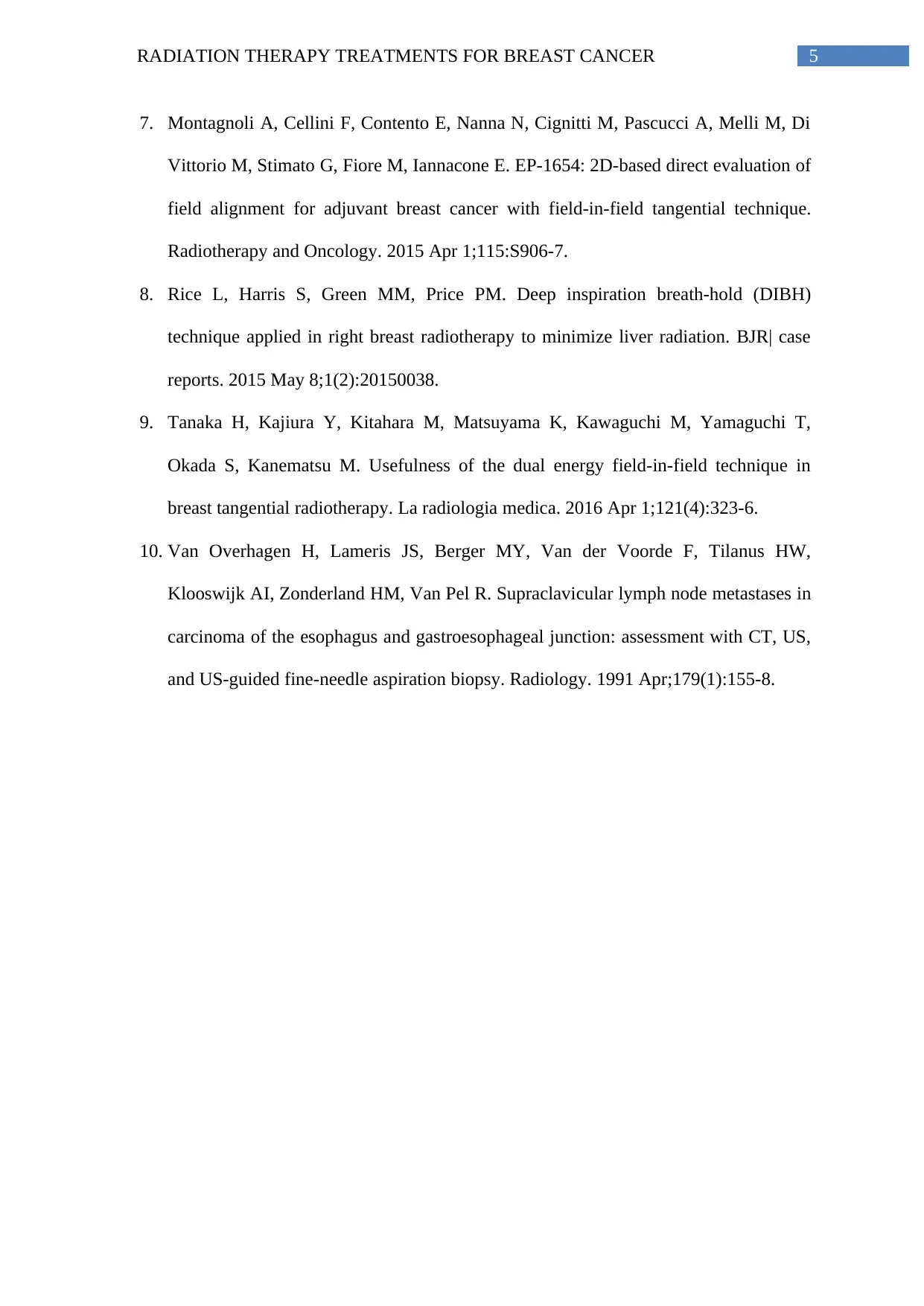
5RADIATION THERAPY TREATMENTS FOR BREAST CANCER
7. Montagnoli A, Cellini F, Contento E, Nanna N, Cignitti M, Pascucci A, Melli M, Di
Vittorio M, Stimato G, Fiore M, Iannacone E. EP-1654: 2D-based direct evaluation of
field alignment for adjuvant breast cancer with field-in-field tangential technique.
Radiotherapy and Oncology. 2015 Apr 1;115:S906-7.
8. Rice L, Harris S, Green MM, Price PM. Deep inspiration breath-hold (DIBH)
technique applied in right breast radiotherapy to minimize liver radiation. BJR| case
reports. 2015 May 8;1(2):20150038.
9. Tanaka H, Kajiura Y, Kitahara M, Matsuyama K, Kawaguchi M, Yamaguchi T,
Okada S, Kanematsu M. Usefulness of the dual energy field-in-field technique in
breast tangential radiotherapy. La radiologia medica. 2016 Apr 1;121(4):323-6.
10. Van Overhagen H, Lameris JS, Berger MY, Van der Voorde F, Tilanus HW,
Klooswijk AI, Zonderland HM, Van Pel R. Supraclavicular lymph node metastases in
carcinoma of the esophagus and gastroesophageal junction: assessment with CT, US,
and US-guided fine-needle aspiration biopsy. Radiology. 1991 Apr;179(1):155-8.
7. Montagnoli A, Cellini F, Contento E, Nanna N, Cignitti M, Pascucci A, Melli M, Di
Vittorio M, Stimato G, Fiore M, Iannacone E. EP-1654: 2D-based direct evaluation of
field alignment for adjuvant breast cancer with field-in-field tangential technique.
Radiotherapy and Oncology. 2015 Apr 1;115:S906-7.
8. Rice L, Harris S, Green MM, Price PM. Deep inspiration breath-hold (DIBH)
technique applied in right breast radiotherapy to minimize liver radiation. BJR| case
reports. 2015 May 8;1(2):20150038.
9. Tanaka H, Kajiura Y, Kitahara M, Matsuyama K, Kawaguchi M, Yamaguchi T,
Okada S, Kanematsu M. Usefulness of the dual energy field-in-field technique in
breast tangential radiotherapy. La radiologia medica. 2016 Apr 1;121(4):323-6.
10. Van Overhagen H, Lameris JS, Berger MY, Van der Voorde F, Tilanus HW,
Klooswijk AI, Zonderland HM, Van Pel R. Supraclavicular lymph node metastases in
carcinoma of the esophagus and gastroesophageal junction: assessment with CT, US,
and US-guided fine-needle aspiration biopsy. Radiology. 1991 Apr;179(1):155-8.
⊘ This is a preview!⊘
Do you want full access?
Subscribe today to unlock all pages.

Trusted by 1+ million students worldwide
1 out of 6
Related Documents
Your All-in-One AI-Powered Toolkit for Academic Success.
+13062052269
info@desklib.com
Available 24*7 on WhatsApp / Email
![[object Object]](/_next/static/media/star-bottom.7253800d.svg)
Unlock your academic potential
Copyright © 2020–2025 A2Z Services. All Rights Reserved. Developed and managed by ZUCOL.




